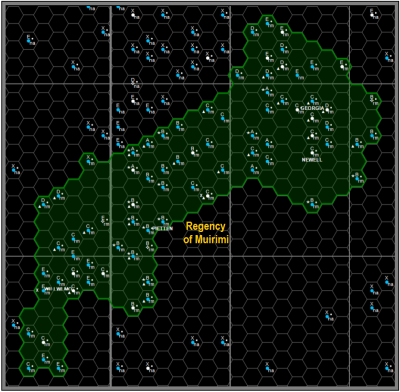Sitaraism
Sitaraism is a religious organization with interstellar reach.
- It is practised within Theron and Iphigenaia Sectors.
- It is the religion of the Muirimi culture.
- It is related to the Church of the Stellar Divinity.
Description (Specifications)[edit]
The basic belief of Sitaraism is that all stars are gods, conscious beings of transcendental power and unimaginable timescales.
If a person worships a chosen star, lives a good and decent life, and follows the teachings of the church, their soul will acquire spiritual mass. Upon the worshipper's death it will separate from their mortal body and be drawn into their chosen star, where it will join with the deity.
Religious Profile[edit]
God View: (2) Polytheism. All stars are divine entities, giving physical and spiritual energy to the worlds that orbit them.
- Stars that have worlds with native life are considered to be "good" entities.
- Stars that don't harbor worlds with native life may be considered to be "evil" entities.
- Different sects favour worship of different stars. These sects may clash with one another.
Spiritual Aim: (3) Worshippers will be received both spiritually and physically into the star, in the fullness of time.
- The believer's conscious mind will merge with the stellar deity upon death, where they will be judged based on their worldly deeds. Those who are found worthy become one with the stellar consciousness, where all things will be known and understood and the departed will be with their loved ones again. Those who are found lacking are ejected as a stellar flare, doomed to wander the icy, empty cosmos forever.
- Ultimately, followers will physically become one with a star. This is a literal thing, achieved (usually over billions of years) by an individual's mortal remains being consumed by the star as it ages, evolves, and expands, swallowing the worlds that orbit it and everything upon them. Eventually, in the fullness of time, the stars themselves will explode and cast their constituent material into space, which will eventually form new stars and worlds, with new life and new intelligence upon them.
- This process may be hastened by the individual's mortal remains being launched into a "good" star close to the end of its natural lifecycle.
- The remains of criminals or wrong-doers may be launched into a "bad star" as part of their punishment.
- Some sects teach a reincarnation philosophy, claiming that the consciousness of the individual will be transferred from the star into "new vessels", beings that have yet to evolve on their future homeworlds.
- Achieving spiritual enlightenment during an individual's lifetime will unlock tangible physical benefits granted by the star deity.
Devotion Required: (4) Prayer is required at dawn and at dusk.
- On worlds where the sun doesn't move in the sky, or moves significantly more slowly than on Terra, devotion is required at regular intervals.
- A number of religious holidays are observed, typically coinciding with annual cycles of particular stars.
- Financial donations to the church are made by the faithful.
Organization Structure: (6) Sitaraism has a formal hierarchical structure with most decisions made on a regional level.
- The head of the church is the Sitara, chosen for life from among the ranks of the Elder Brahma.
- Elder Brahma are intellectuals and theologians who advise the Sitara on matters and administer regions roughly corresponding to subsectors. They are chosen from among the Brahma.
- Brahma are religious leaders who administer individual worlds, or on more heavily populated worlds administer different regions of the surface.
- Priests run parishes and minister to the faithful. Over time they may become Brahma, though not all seek such a role.
- Religious services are held in large, gaudily decorated temples. Temples have a central space either open to the sky or covered with a transparent dome.
- Isolated, self-sufficient monasteries house and train those seeking spiritual enlightenment.
Liturgical Formacy: (7) Rituals are combined with moderate teaching.
- Sacred texts are widely available.
- Services are conducted in common languages.
- Teachings guide the faithful towards personal enlightenment
- Religious leaders wear characteristic clothing.
Missionary Fervor: (2) Zealous and intolerant of non-believers.
- Worlds and their resources are a gift to the faithful from the star deities.
- Non-believers have no right to take the gifts of the gods.
- The faithful have every right to defend what is theirs and take the gifts of the gods for themselves.
Number Of Adherents: (A) Estimated at 13 billion.
History & Background (Dossier)[edit]
The religion originated in the Indian subcontinent of Terra during the Rule of Man.
The Regency of Muirimi, the heartland of Sitaraism.
- The Muirimi peoples practise Sitaraism as a fundamental aspect of their culture.

(Chart sourced from Traveller Map).
Sects[edit]
Various sects exist within Sitaraism.
- The primary sects are Unitary Sitaraism, Pietten Sitaraism, and the Georgian School. All hold the same basic beliefs and hold the Elder Brahma as the head of the faith, but differ on their views of the donations and commitments required to become one with the star, the nature of the afterlife, the rights of individuals to own property, appropriate dress, and marriage customs.
- A number of smaller sects hold what are considered to be subversive, extreme, or in a few cases heretical beliefs.
- Other than heretical sects, most are willing to cooperate with one another in the face of a greater threat.
- Heretical sects, as a rule, refuse to accept the primacy of the Elder Brahma.
Worlds & Sectors (Astrography)[edit]
The church makes relatively few demands on a worshiper's life and doesn't compete with the government.
It is primarily located in the following areas:
Charted Space:
World Listing: 1105[edit]
This religion is known to be found on the following systems and worlds:
| startbacknext(30 listed) |
References & Contributors (Sources)[edit]
- Classic Traveller Grand Census, p 40-41, 46-47 (URP details).
- Author & Contributor: Lord (Marquis) and Master Scout Emeritus Adie Alegoric Stewart of the IISS
